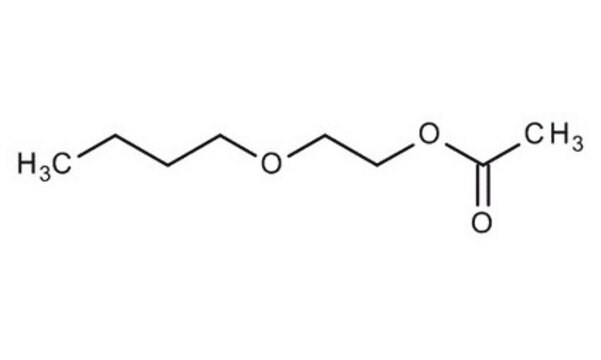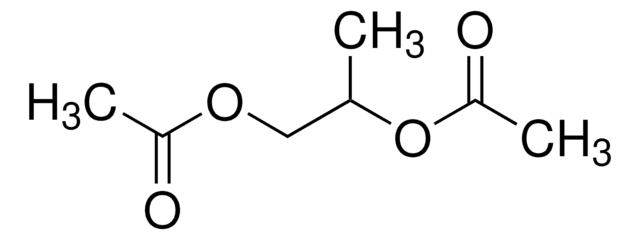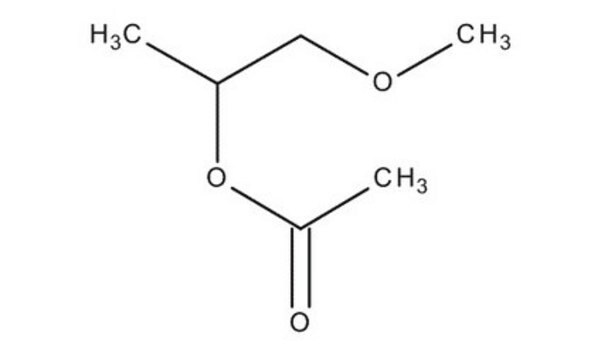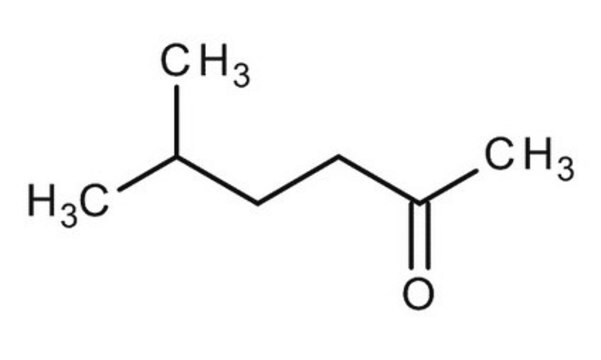307289
2-Butoxyethyl acetate
99%
Synonyme(s) :
1-Acetoxy-2-butoxyethane, BCA, Ethylene glycol monobutyl ether acetate
About This Item
Produits recommandés
Densité de vapeur
5.5 (vs air)
Niveau de qualité
Pression de vapeur
0.29 mmHg ( 20 °C)
Essai
99%
Forme
liquid
Température d'inflammation spontanée
644 °F
Limite d'explosivité
0.88 %, 33 °F
8.54 %, 135 °F
Indice de réfraction
n20/D 1.413 (lit.)
pb
192 °C (lit.)
Densité
0.942 g/mL at 25 °C (lit.)
Groupe fonctionnel
ester
ether
Chaîne SMILES
CCCCOCCOC(C)=O
InChI
1S/C8H16O3/c1-3-4-5-10-6-7-11-8(2)9/h3-7H2,1-2H3
Clé InChI
NQBXSWAWVZHKBZ-UHFFFAOYSA-N
Vous recherchez des produits similaires ? Visite Guide de comparaison des produits
Catégories apparentées
Description générale
Application
- Three-Dimensional Printing of Scaffolds: 2-Butoxyethyl acetate was utilized in the synthesis of poly(glycerol sebacate) acrylate for 3D printing applications, highlighting its role as a solvent in developing biocompatible materials for medical implants and tissue engineering (Wu et al., 2020).
- Migration Analysis in Food Contact Materials: Demonstrates the application of 2-Butoxyethyl acetate in the extraction and analysis of migrating compounds from plastic baby bottles, using GC-MS to ensure consumer safety and compliance with food safety regulations (Onghena et al., 2014).
Mention d'avertissement
Warning
Mentions de danger
Conseils de prudence
Classification des risques
Acute Tox. 4 Dermal - Acute Tox. 4 Inhalation - Acute Tox. 4 Oral
Code de la classe de stockage
10 - Combustible liquids
Classe de danger pour l'eau (WGK)
WGK 1
Point d'éclair (°F)
168.8 °F - closed cup
Point d'éclair (°C)
76 °C - closed cup
Équipement de protection individuelle
Eyeshields, Faceshields, Gloves, type ABEK (EN14387) respirator filter
Faites votre choix parmi les versions les plus récentes :
Déjà en possession de ce produit ?
Retrouvez la documentation relative aux produits que vous avez récemment achetés dans la Bibliothèque de documents.
Les clients ont également consulté
Notre équipe de scientifiques dispose d'une expérience dans tous les secteurs de la recherche, notamment en sciences de la vie, science des matériaux, synthèse chimique, chromatographie, analyse et dans de nombreux autres domaines..
Contacter notre Service technique














